
1. Felbamate
1.1. Use
1.1.1. Partial seizures in adults
1.1.1.1. Both of the are very serious seizures
1.1.2. Lennox-Gastaut Syndrome in kids
1.2. SE
1.2.1. High incidence of aplastic anemia and liver failure
1.2.1.1. Only used on "compassionate use" basis
2. Vigabatrin
2.1. MOA
2.1.1. Inhibits GABA degradation (GABA transaminase) and reuptake
2.1.1.1. Increases GABA-mediated inhibition
2.2. Use
2.2.1. DLR for infantile spasms and refractory complex partial seizures
2.2.1.1. CP seizures are notoriously hard to control
2.3. SE
2.3.1. 30% of pts have vision loss
2.3.2. headache, somnolence fatigue, dizziness
3. Rufinamide
3.1. Use
3.1.1. Lennox-Gastaut syndrome
3.2. MOA
3.2.1. acts on Na channels
3.3. SE
3.3.1. somnolence, vomiting
4. Adjunct drugs (for parital seizures)
4.1. Lamotrigen
4.1.1. Use
4.1.1.1. Partial seizures
4.1.1.2. Neuropathic pain
4.1.2. MOA
4.1.2.1. Slows recovery in Na channels
4.1.2.2. Inhibits V-G Ca channels
4.1.2.3. Inhibits Glutamate release
4.1.3. SE
4.1.3.1. Most common: weakness, diplopia, ataxia, N, irritability, SJS
4.1.3.2. Teratogen: increase risk of cleft palate
4.1.3.3. DDI
4.1.3.3.1. Inhibits carbarmazepine metab
4.2. Gabapentin
4.2.1. Use
4.2.1.1. Partial seizures
4.2.1.2. Neuropathic pain
4.2.2. MOA
4.2.2.1. Acts as a subunit of V-G Ca channels to decrease depolarization-induce Ca influx
4.2.2.1.1. decreases release of glutatmate (excitatory NT)
4.2.3. SE
4.2.3.1. somnolence, dizziness, ataxia, fatigue, wt gain, nystagmus
4.2.3.2. DDI
4.2.3.2.1. No major problems!
4.3. Topiramate
4.3.1. Use
4.3.1.1. Partial seizures
4.3.1.2. Tremors
4.3.1.3. Migraine prevention
4.3.2. MOA
4.3.2.1. Blocks Na channels & AMPA/Kainate receptors
4.3.3. SE
4.3.3.1. Difficulty concentrating, drowsiness, dizziness, ataxia
4.3.3.2. Wt loss!!!
4.3.3.3. Increased risk of kidney stones
4.3.3.4. Inhibits carbonic anhydrase
4.3.3.4.1. Measure serum bicarb before starting
4.3.3.4.2. Metabolic acidosis may result
4.4. Pregabalin
4.4.1. SE
4.4.1.1. somnolence, dry mouth, blurred vision, peripheral edeam, wt gain
4.4.1.2. Euphoria - Schedule V
5. Practical aspects of Drug Tx
5.1. Status epilepticus
5.1.1. State of continuous seizure activity
5.1.2. Generalized T/C type is 10% fatal
5.1.3. Usually d/t sudden withdrawal of CNS depressants or drug poisoning
5.1.4. Tx
5.1.4.1. Supportive care
5.1.4.1.1. Electrolytes, cardiac arrhythmia, ABCs
5.1.4.2. Drug
5.1.4.2.1. 1) IV diazepam or lorazepam
5.1.4.2.2. 2) Maintenance Tx of slow IV phenytoin of PBB infusion
5.2. Monotherapy
5.2.1. Multiple drug Tx only used if:
5.2.1.1. >1 seizure type is present
5.2.1.2. single drug fails to provide adequate control near toxic levels
5.2.2. Remember therapeutic concentration is close to toxic levels for most drugs
5.2.2.1. watch for signs of toxicity
5.3. Pregnancy
5.3.1. Use lowest dose that will control seizures
5.3.2. Teratogenic, but uncontrolled seizure also unsafe for fetus
5.3.3. Supplement w/ Vit K and folic acid
6. Seizure Tx
6.1. Grand Mal (Primary generalized Tonic-clonic)
6.1.1. Valproate OR carbamazepine OR phenytoin
6.2. Partial (including secondarily generalized)
6.2.1. Valproate OR carbamazepine OR phenytoin
6.3. Absence (Petit mal)
6.3.1. Ethosuximide OR Valproate
6.4. Atypical absence, myoclonic, atonic
6.4.1. Valproate
